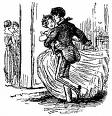
[This is taken from Routledge's Manual of Etiquette.]
La Tempete was brought over to this country from Paris some years ago. It speedily became a favorite, and for several seasons was much danced in London and the provinces. It unites the cheerfulness of the quadrille with the sociability of the country dance; and when its lively figures are correctly performed, it is both amusing and animated.
It is divided into parties of four couples, like the quadrille; but their arrangement is different. Two couples stand side by side, facing their respective vis-à-vis; there are not any side couples. As many sets of four couples can be thus arranged as the room will accommodate. Each new set turns its back upon the second line of the preceding set. Thus the dance can be the whole length of the room, but is only the breadth of two couples. The figure is as follows:--
Place two couples side by side, the lady standing at the right hand of the gentleman. Place two other couples as their vis-à-vis. Next place two couples with their backs turned to the first set; two couples opposite them for their vis-à-vis; and continue arranging more sets of four couples according to the number of the dancers and the size of the room.
First part.—All the couples begin at the same moment, by advancing and retreating twice, with joined hands. First couples (that is, all whose backs are turned to the top of the room) cross, with hands joined, to the places of their vis-à-vis. The latter cross at the same time, but, separating, pass outside top couples to the top, where they join hands, return to own places, and back again to the top without separating; the top couples crossing separately at the same time outside the second couples. Top couples then join hands, and all return to their own places, second couples separating to allow the others to pass between them.
Lady and gentleman in the centre of each line join hands, giving their disengaged hands to their two vis-à-vis. All four half round to the left, then half round back again to places. Meantime, the outside lady and gentleman perform the same with their respective vis-à-vis, making a circle of two instead of four. Circle of four give hands across round; change hands; round once more, and back to places. Outside couples perform same figure in twos. All the sets perform the figure at the same moment.
Second part.—All advance, retreat, and advance again; all the top couples passing the second couples into the next line, where they recommence the same figure, their former vis-à-vis having passed to the top, and turned round to wait for a fresh vis-à-vis; gentleman always keeping lady at his right hand. An entire change of places is thus effected, which is continued throughout this figure, until all the top lines have passed to the bottom, the bottom lines at the same time passing to the top; and then turning round, all go back again by the same method reversed, till all have regained their original places. The dance may terminate here, or the last figure may be repeated, at pleasure. When the first exchange of vis-à-vis takes place, the new lines at the top and bottom find themselves for a moment without a vis-à-vis; but, at the next move forward, they are provided, and can continue the figure as above described. We extract from a contemporary the following graceful variation in the first half of this dance:--“All advance and retire twice (hands joined). All vis-à-vis couples chassez croisez en double, each gentleman retaining his partner’s left hand; eight galop steps (four bars);
dechassez eight steps (four steps), the couple on the right of the top line passing in front of the couple on the left the first time, returning to place, passing behind. Thus, two couples are moving to the right, and two to the left. This is repeated. The vis-à-vis couples do likewise at the same time. This of course applies to all the couples, as all commence at the same time.”
La Tempete is danced to quick music, in 2/4 time. The steps are the same as in quadrilles; varied sometimes by the introduction of the galop step, when the couples cross to each others’ places or advance into the lines of the next set.
Copyright © D. J. McAdam· All Rights Reserved